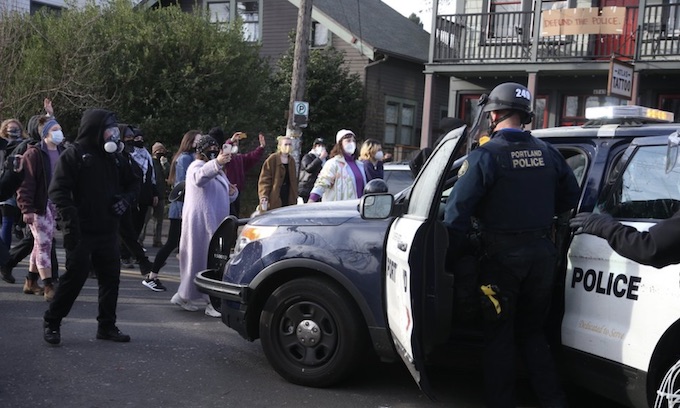Mayor Ted Wheeler said late Tuesday that he had authorized police to “use all lawful means to end the illegal occupation.”
The initial confrontation between police and protesters unfolded hours earlier after police arrived to help the new property owner fence off the house. The house was sold at a 2018 foreclosure auction. The former property owners unsuccessfully challenged their eviction.
Portland Police retreated both on foot and vehicle after responding to the antifa autonomous zone in north Portland yesterday. The street occupation has continued to grow in the hours since and more comrade reinforcements have come in to protect the zone. pic.twitter.com/GMCqFZ7QDf
— Andy Ngô (@MrAndyNgo) December 9, 2020
The Kinney family’s case gained prominence as calls for racial justice took hold this summer. The house sits within a historically Black residential neighborhood that has gentrified and now is the home to many condominiums and mixed-use buildings. Protesters have camped for months to stall the eviction.
Wheeler said late Tuesday that the eviction was the result of a thorough legal process. His comments arrived as the home’s longtime residents guided reporters and others through the house, which they said police had damaged earlier that day.
William Nietzche, 35, walked through his childhood bedroom and pointed out the places where he said officers rifled through his belongings. The closet door in William’s childhood bedroom appeared to have been ripped off, leaving a small strip of wood still on its hinges.
Nietzche and six others were arrested to officers who arrived at the home early Tuesday morning. Portland police said many of the people arrested were trespassing on the property.
Nietzche said he believes his fingers, as well as his wedding ring, were broken in the arrest. He was later released.
”It’s devastating,” said Nietzche, who said his family is Upper Skagit. “It’s almost like a dream. Like a nightmare.”
Family matriarch Julie Metcalf Kinney, 62, said she appreciated people trying to help the family retain their home they had owned since 1955. She described the court process to try to save the family’s home as long and horrendous.
“My husband has been here since he was four,” she said. “This has been his family home. He’s completely devastated.”
Outside the house, the crowd intermittently chanted criticisms of Wheeler, as well as “This is what community looks like!”
Antifa and left-wing extremists in Portland have built a new autonomous zone in the middle of north Portland on a busy street. They are protecting the illegal squatters at a house. pic.twitter.com/qF8yOsJfKU
— Andy Ngô (@MrAndyNgo) December 8, 2020
Construction continued on makeshift barricades in the streets surrounding the home. The structures were built from chain link fence, wooden planks, wooden boards, car tires, chunks of wood and an old bookshelf.
Occupiers also prepared for the possibility that police may return. Some people set up piles of homemade shields and traffic cones, the latter meant to diffuse smoke canisters launched by police.
The crowd began to grow shortly after officers first arrived Tuesday morning. Multnomah County Sheriff’s Office deputies and other officers were attempting “to re-secure a home in which the occupants were previously ordered removed by court order,” the agency said in a news release.
More video of how antifa in Portland attacked police at the autonomous zone and made them retreat. They sprayed a chemical all over one police cruiser’s front window to completely block the view while others threw projectiles. pic.twitter.com/La91Tn2F5r
— Andy Ngô (@MrAndyNgo) December 9, 2020
Police said while officers were standing on the property’s perimeter, a crowd began to gather and officers were struck by projectiles such as rocks and paint-filled balloons.
After fence and cleanup crews finished their work Tuesday morning, officers left the area, police said. But the crowd pulled down the fence and entered the property, spurring police to return. Those officers were outnumbered by the 200 people who had amassed in opposition of the eviction.
Protesters confronted police. Law enforcement ultimately retreated as police vehicles were damaged, including at least one window smashed. Protesters threw rocks at officers, and one sprayed a fire extinguisher at them, prompting an officer to deploy an impact munition.
One police vehicle hit a parked car as the officer driving it tried to leave.
The tense scene quieted after police left about 10:30 a.m. Demonstrators took the fencing erected earlier and built barricades around the property, known as the “Red House on Mississippi.” They piled up rocks and bricks, ostensibly as projectiles for any further clashes. Some people also prevented certain members of the media from accessing the area inside the barricaded zone.
Deputy Police Chief Chris Davis said Tuesday evening police officials plans a measured response but offered no details.
“I certainly am respectful of the issue that people are there to address, but blocking streets and chasing police officers out of the neighborhood is still not OK and really contrary to our values as Portlanders,” Davis said.
“We’re concerned for the safety of the neighborhood and we know this has a really big impact on the people who live there,” he said.
Eric VanGelder, 38, who lives near the house, surveyed the scene with his 4-year-old daughter around 7 p.m. He said he was curious what was unfolding in his backyard.
”Right now I’m just really, really hopeful that people don’t get hurt,” he said. “I think there’s probably going to be a lot of pressure to use this street again, so maybe there can be some kind of thoughtful concessions so that the street is peacefully reopened by the people who blocked it, rather than forcibly reopened in a bloody mess.”
HOUSE HISTORY
The house, built in 1896, belonged to the Kinney family for about six decades, starting in the 1950s, according to the Red House on Mississippi website.
Sign: “Fascism is capitalism in decay”
Some antifa are calling their Portland street occupation the “Red House Autonomous Zone,” or RHAZ. The “Red House” is the name given to a property being illegally occupied by squatters & far-left extremists. pic.twitter.com/t4epsl9pXS
— Andy Ngô (@MrAndyNgo) December 9, 2020
The Kinneys’ problems with the house, which had been paid off, began when they took out a new mortgage to pay defense lawyers after a family member was arrested in 2002, the website says.
In 2018, the lender foreclosed for non-payment and sold the house to a developer in an auction, public records show. But the Kinneys kept living in the home. They argued in court filings this year that Oregon’s moratorium on evictions and foreclosures amid the pandemic meant they couldn’t be forced out of the home this year.
But the red house foreclosure and sale occurred years before the moratorium went into effect. In September, a judge rejected the family’s argument and instructed law enforcement to turn the house over to its rightful owner, Urban Housing Development Ltd.
Activists and others have been camping at the property in an effort “to reclaim” it for the Kinneys since the September ruling.
Deputies served a court order at the home that said the defendants were unlawfully occupying the premises. The “Writ of Execution of Judgment of Restitution” gave the sheriff 120 days to serve the order to the occupants, and it was extended for another 120 days on Oct. 22.
The Sheriff’s Office said it gave the people there time to gather their things and offered them housing and shelter options, as well as other resources.
“We understand evictions are challenging proceedings even in the best of circumstances,” Sheriff Mike Reese said in a statement. “I believe everyone should have access to appropriate housing.”
Police said they have received numerous complaints from the neighborhood about the ongoing encampment. From Sept. 1 to Nov. 30, the Police Bureau reported it had received more than 80 calls for a variety of issues, including fights, shots fired, noise and threats.
Community members created a “Save the Kinney Family Home” GoFundMe page in September, seeking $250,000. The effort has raised just over $41,000 so far.
The area, which historically was a Black residential neighborhood, in the past two decades has gentrified and become predominantly mixed-use retail and residential with the addition of larger-scale condominiums. Many single-residence homes along the section of Mississippi have been torn down or converted to retail.
Beth Nakamura, Ted Sickinger, Maxine Bernstein, Shane Dixon Kavanaugh, Jayati Ramakrishnan and Doug Perry of The Oregonian/OregonLive contributed to this story, which will be updated throughout Tuesday evening.
— Catalina Gaitán and Brooke Herbert
___
(c)2020 The Oregonian (Portland, Ore.)
Visit The Oregonian (Portland, Ore.) at www.oregonian.com
Distributed by Tribune Content Agency, LLC.
—-
This content is published through a licensing agreement with Acquire Media using its NewsEdge technology.



















There is no difference between Mayor Ted Wheeler and Antifa. Ted Wheeler gave Antifa and blm free reign in destroying Portland.
YET< how DARE YOU hold a party in your home..
ANTIFA RULES portland.
the police chief should tell the mayor to send in social workers first.
The entire police force in Oregon, needs to go on STRIKE.
“The house sits within a historically Black residential neighborhood that has seen recent investments and now is thriving with many condominiums and mixed-use buildings.”
Fixed it for you!
I BET IT won’t be thriving anymore, as all those investors FLEE THE STATE< not just the city!
I’m poor and I pay my bills. Why not just pay your mortgage ???
Probably too busy buying drugs and alcohol, to pay their bills.
Build a mini prison using tents, arrest every single one of them, dress them in orange, give them a cold sandwichs to eat and make them clean up the mess they made. No exceptions, if they are there they are guilty and arrest them! Take their time processing so each one of them has to spend several days there, each time they are arrested, 2nd arrest 3 months, on the 3rd arrest 6 months, 4th arrest 1 year, 5th 2 years and all of them are labor camps.
Now’s about CUT ALL water, power and cell phone service, then seal the entire area up, with shipping containers stacked 6 tall… SEE HOW LONG IT GETS before they’re BEGGING TO be let out.
“The Kinney family’s case gained prominence as calls for racial justice took hold this summer. The house sits within a historically Black residential neighborhood that has gentrified and now is the home to many condominiums and mixed-use buildings. Protesters have camped for months to stall the eviction.”
Now, imagine if the paragraph read like THIS:
The Kinney family’s case gained prominence as calls for religious justice took hold this summer. The house sits within a historically White residential neighborhood that has Islamophied and now is the home to many mosques and Imams. Protesters have camped for months to stall the eviction.”
The media wouldn’t DARE report that. Can’t say anything good about christians, can they.
How anyone seeing this unfold can still support Hidden/Horizontal is just shocking.
The Greatest Generation must be wondering is this really what we fought for ?!?
I mentioned that on news max, and they ‘censured’ the comment as “BEING TOXIC”?
With the first rock/paint filled balloon thrown, the police should open up with live rounds, and keep firing until all of these “protesters” are down. Assault on a police officer, by an angry mob, should generate no less of a response.
IT SHOUDL. BUT as we’ve seen this entire year. COPS ARE TOO EMASCULATED, to ever respond it seems.. Theyve literally become nothing more than WALKING TARGETS..
In 2018, the lender foreclosed for non-payment and sold the house to a developer in an auction, public records show. But the Kinneys kept living in the home.
Really?
If you borrow money and you don’t pay it back, I am sure you signed something stating you can have the property I put as collateral if I fail to pay.
So what is stopping the police from using force to arrest all these trespassers?
Sorry former owners, but you messed up.
What’s stoping the cops?? HOWS ABOUT SHEER unadulterated cowardice!